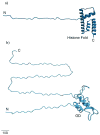Multifunctionality of the linker histones: an emerging role for protein-protein interactions
- PMID: 20309017
- PMCID: PMC2919278
- DOI: 10.1038/cr.2010.35
Multifunctionality of the linker histones: an emerging role for protein-protein interactions
Abstract
Linker histones, e.g., H1, are best known for their ability to bind to nucleosomes and stabilize both nucleosome structure and condensed higher-order chromatin structures. However, over the years many investigators have reported specific interactions between linker histones and proteins involved in important cellular processes. The purpose of this review is to highlight evidence indicating an important alternative mode of action for H1, namely protein-protein interactions. We first review key aspects of the traditional view of linker histone action, including the importance of the H1 C-terminal domain. We then discuss the current state of knowledge of linker histone interactions with other proteins, and, where possible, highlight the mechanism of linker histone-mediated protein-protein interactions. Taken together, the data suggest a combinatorial role for the linker histones, functioning both as primary chromatin architectural proteins and simultaneously as recruitment hubs for proteins involved in accessing and modifying the chromatin fiber.
Figures

References
-
- Luger K, Mader AW, Richmond RK, Sargent DF, Richmond TJ. Crystal structure of the nucleosome core particle at 2.8 A resolution. Nature. 1997;389:251–260. - PubMed
-
- Burlingame RW, Love WE, Wang BC, Hamlin R, Nguyen HX, Moudrianakis EN. Crystallographic structure of the octameric histone core of the nucleosome at a resolution of 3.3 A. Science. 1985;228:546–553. - PubMed
-
- Thomas JO, Butler PJ. Characterization of the octamer of histones free in solution. J Mol Biol. 1977;116:769–781. - PubMed
-
- Ruiz-Carrillo A, Jorcano JL. An octamer of core histones in solution: central role of the H3-H4 tetramer in the self-assembly. Biochemistry. 1979;18:760–768. - PubMed
-
- Luger K, Richmond TJ. DNA binding within the nucleosome core. Curr Opin Struct Biol. 1998;8:33–40. - PubMed
Publication types
MeSH terms
Substances
Grants and funding
LinkOut - more resources
Full Text Sources

